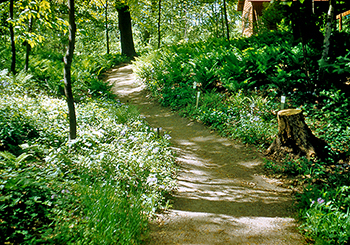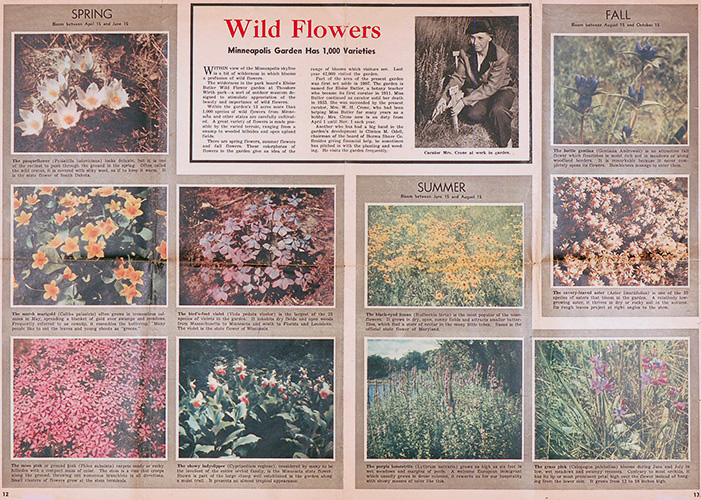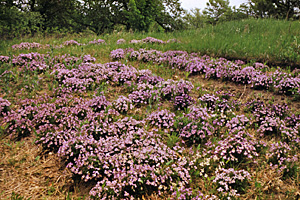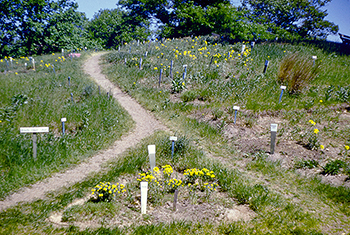
1950
History
of the Eloise Butler Wildflower Garden
1950 is the 44th year of the Garden and Martha Crone begins her 18th year as Garden Curator.

NOTE on photos: From 1948 to 1957 Martha Crone assembled a collection of Kodachrome slides that she took of plants and landscape of the Wildflower Garden. The assemblage eventually totaled over 4,000 slides. She used these slides to give illustrated lectures about the Garden to various clubs, groups and organizations. Martha Crone was a founding member of the Friends of the Wild Flower Garden, a director from 1952 to 1972 and an honorary life member thereafter.
After her death in 1989 her daughter Janet, passed the collection to the Friends via Friends member Martha Hellander who was in the process of researching a book about Eloise Butler. The Friends sorted the collection and then for a short time, used them at lectures about the Garden. Some of those images are shown on this page.
Many new plants set out in 1950 are, again like 1946 to ’49, non native, apparently an attempt to see what would grow in the new prairie area and one has to question why Martha is experimenting with all these plants when the premise of the Garden was: “Here can be seen in season practically all native flowers of Minnesota.” (1)
She would apparently justify her position with a modification summarized in this comment from 1966 after she retired as curator:
The object is to bring together all the native plants hardy in this latitude, also to experiment with plants introduced from other areas.(2)
Many of these imported species did not last even until the 1951 census, let alone later years. The source is given for some of new plants.

The first Garden Log entry for the season is on April 1st, opening day:
Appearance of midwinter. Deep snow & ice everywhere, also very cold. Gates still locked. Stove keeps office snug and warm.
This would be another fickle spring just like 1949. On April 8, 9, 10 she noted:
More snow, hail, rain and electric storm. Snow melting slowly.
Then between April 14 and 17:
Real warm and springlike. Removed hay in upper garden on the 15th and 17th. Skunk cabbage, Snow Trilliums and Pasque-flower thru the ground. Ice still on lakes.
The hay had been placed on the plantings in the upper Garden to protect them from freeze-thaw cycles. Martha and her successor Ken Avery frequently did this when they were able to work late into the fall season.
The first Snow Trilliums and the Skunk Cabbage came into bloom on April 18 . Her first planting of the season was on the 20th with 170 Snow Trillium from Mankato.
A large number of plants new to the Garden were introduced in the spring. "Native" refers to a plant found in the wild in Minnesota, at settlement time. "Introduced" means the plant is found here but originally imported from somewhere else. "Not native" means the plant has not been found in the wild in Minnesota but is native to elsewhere in North America. If the species survived until the 1951 census it is noted in the list. Updated scientific names are given in [ ].
On May 28: A number of plants in 5 genus were received from Oscar Will, Bismarck ND. no species listed, non are native, none on 1951 census. Two of the five are new to the Garden.
- Genus Gloriosa, Flame Lily
- Genus Mammillaria, cactus
On May 29: 17 species from Claude Barr, Southwick SD - “plants always arrive in fine condition.” (many are rock garden plants). Only the first listed species shows up on the 1951 census.

- Astragalus goniatus, [Astragalus agrestis] Purple Milkvetch, Field Milkvetch, Native.
- Astragalus tridactylicus, Foothill Milkvetch, not native.
- Dalea ennenndra, Nineanther Prairie Clover, not native.
- Erigeron caespitosus. Tufted Fleabane, not native.
- Gutierrezia sarothrae, Broom Snakeweed, not native.
- Leucocrinum montanum, Common Starlily, not native.
- Oenothera brachycarpa, Shortfruit Evening Primrose, not native.
- Oenothera lavandulifolia [Calyophus lavandulifolius], Lavenderleaf Sundrops, not native.
- Penstemon glaber, Sawsepal Penstemon, not native.
- Penstemon procumbens ‘Claude Barr’, not native, USDA does not recognize that name as it is a commercial hybrid - assigns to P. caespitosus. A number of authors take exception.
- Sideranthus spinulosus, [Xanthisma spinulosum via Machaeranthera pinnatifida], Lacy Tansyaster, Cutleaf Ironweed. native - Special Concern list in Minnesota.
- Townsendia excapa, Stemless Townsend Daisy, not native.
The last new plant was Shortia galacifolia, Oconee Bells, not native, from Lounsberry in Oxford IL. Martha was fond of this plant and wrote about it several times in The Fringed Gentian™.
Only two bird notes were recorded: “Many Fox Sparrows singing” on April 29th and “large warbler waves through” on May 18th.
On May 21st the Minneapolis Tribune ran a double page spread in their Picture Magazine about the Garden. The text was short, with a photo of Martha Crone in the Garden, in her usual slacks and tam-o-shanter. The photo and the text are the same as was used in an August 27, 1947 article in the Tribune Besides speaking of Eloise Butler and Martha Crone, it highlights the efforts of Clinton Odell:
Another who has had a big hand in the garden’s development is Clinton M. Odell, chairman of the board of Burma Shave Co. Besides giving financial help, he sometimes has pitched in with the planting and weeding. He visits the garden frequently.
The spread had 10 color photos of plants seen in spring, summer or fall with a description of the plant. Martha made no mention in her log about any increase in visitors that week.
Below: The May 21 newspaper spread. Click on image for larger copy.


Three plants new to the Garden were introduced in the summer. two species survived until the 1951 - noted in the list. One is questionable as to what she actually planted.
- Dianthus deltoides, Maiden Pink, introduced from Mrs. Solhaug (Hazel).
- Campanula cervicaria, Bristly Bellflower, introduced, “growing along road about 10 miles north of Duluth,” extant in 1951 and today. She logged the plant as Campanula glomerata, which is also non-native, introduced from Europe, its' only known habitat in Minnesota outside of gardens is in St. Louis County near Duluth where it has been collected at the former agricultural test plots. The DNR surveys report that C. cervicaria is found in both Lake and St. Louis Counties in the Arrowhead region. Thus it is most probable that Bristly Bellflower is the species she brought in, not C. glomerata.
On July 15 she put in Arethusa bulbosa, Dragon’s Mouth, from Deer River MN, 24 plants. This is a MN native orchid that she wrote about in her annual report. She previously planted it in 1935 as did Eloise Butler in 1928 and ’30. It survived for a number of years but is no longer extant.
Late August was cold. Martha’s notes: Aug. 20: “Heavy frost, altho some Sensitive Ferns were the only plants destroyed here.” Aug. 28: “Cold rain all day - fire in stove entire day.”
By the end of summer Martha had set out 2,448 plants, including all of the above. There were not any bird notes in the Summer months.

By the time the Garden closed the total count of plants set out in 1950 was 3,122. All the plants set up in the autumn months were species already found in the Garden.
In late November she only planted a few Pitcher plants and this curiosity on November 20th, her last entry of the year:
Planted 10 Lotus Lily bulbs, also obtained 3 loads of soil from Lake Susan on Mr. Klein’s land, 1 mile south of Chanhassen. My pool froze over before soil was filled in, so had it dumped on ice.
[This may explain why Ken Avery had trouble with the water channel silting in the early 60’s] Martha always planted Lotus Lily late in the year, sometime by making holes in the ice covered pool and dropping them in. It is also somewhat strange that she brought in soil for the pool, when she had just enlarged the pools in 1948, unless the peaty subsoils were not suitable for the plants she wanted.
As in the previous year, and even with the reduced plant count, there were some existing species that were planted in very large numbers at various times during the year. Rather than list them by season, here is the list for the year of such plants:
Trillium nivale, Snow Trillium, 170 plants.
Viola pedata, Bird’s-foot Violet, 500.
Many of these could be seedlings that Martha had seeded in flats the prior year.
She summarized the years activities in her annual report (3). Here are additional items.

Among the plants added is one that has never been introduced before altho native to Minnesota. It is the rare orchid Arethusa (Arethusa bulbosa). (Martha evidently did not check her records as she clearly listed planting the species on June 24, 1935 with plants from the Gunflint Trail and Eloise had planted it in 1928 and ‘30.) (4) It is hoped that it will become firmly established. After many years of effort success has been gained with such elusive plants as the lovely Fringed Gentian, Trailing Arbutus and various orchids.
The mimeographed brochure proved a great success and filled a much needed want.
The brochure was something she requested in 1949. In 1951 she developed it further by including a Garden history and a plant list. She estimated the attendance at 48,000, then announced that she was putting together the following: “A complete collection of Kodachrome slides is being made of the flora of the garden. These were shown with lectures on the Wild Flower Garden to Organizations during the Winter.” She actually started taking the images in 1948. In 1951 she would begin to provide listings of slide showings and attendance at them.
Martha completed a tool inventory of the garden in November 1950. How strange today to not see anything with an electric motor, a battery, or a gas engine.
Notes:
(1) The Fringed Gentian™, Vol. 19 No. 2 April 1971
(2) The Fringed Gentian™, Vol. 14 No. 1 January 1966
(3) Annual Reports of the Garden Curator to the Board of Park Commissioners - dated February 7, 1951 to Charles E. Doell.
(4) Garden logs.
Photo top of page: The Upland Garden hillside; photographed on July 30, 1950 by Martha Crone.
Printable PDF file of this page.
Links to related pages:
- Abbreviated Life of Eloise Butler
- Martha Crone - 2nd Garden Curator
- Ken Avery - 3rd Curator and Gardener
- Cary George - 4th Gardener
- Our Native Plant Reserve - Short document on the origins of the Garden.
- Eloise Butler's writings, a selection of essays written by Eloise Butler on the early Garden years.
- Geography of the Garden- an illustrated tour
References:
Martha Crone's Garden Log and her 1951 Census of plants in the Garden.
Various papers and correspondence of Eloise Butler and Martha Crone in the collection of the Minnesota Historical Society.
Photos by Martha Crone are from her collection of Kodachromes that was given to the Friends by her daughter Janet following Martha's death in 1989.
Meeting Minutes and correspondence of the Friends of the Wild Flower Garden.
Historical Climatology of Minneapolis-St. Paul Area by Charles Fisk.